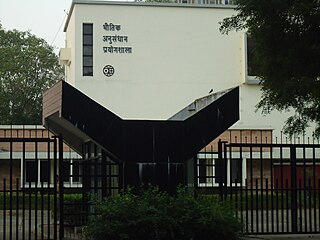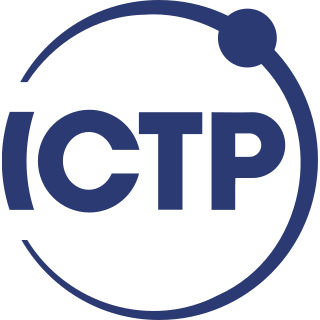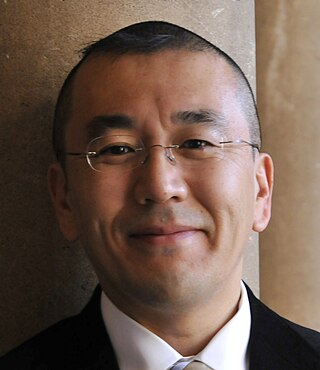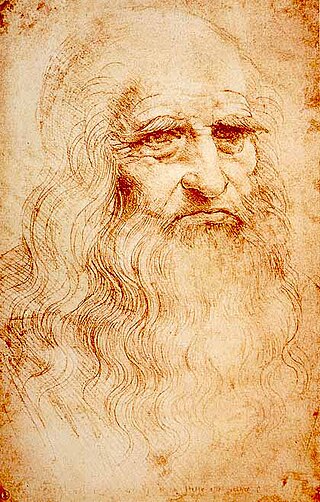The Max Planck Institute for Extraterrestrial Physics is part of the Max Planck Society, located in Garching, near Munich, Germany. In 1991 the Max Planck Institute for Physics and Astrophysics split up into the Max Planck Institute for Extraterrestrial Physics, the Max Planck Institute for Physics and the Max Planck Institute for Astrophysics. The Max Planck Institute for Extraterrestrial Physics was founded as sub-institute in 1963. The scientific activities of the institute are mostly devoted to astrophysics with telescopes orbiting in space. A large amount of the resources are spent for studying black holes in the galaxy and in the remote universe.

The International School for Advanced Studies is an international, state-supported, post-graduate-education and research institute in Trieste, Italy.

The Physical Research Laboratory is a National Research Institute for space and allied sciences, supported mainly by Department of Space, Government of India. This research laboratory has ongoing research programmes in astronomy and astrophysics, atmospheric sciences and aeronomy, planetary and geosciences, Earth sciences, Solar System studies and theoretical physics. It also manages the Udaipur Solar Observatory and Mount Abu InfraRed Observatory. The PRL is located in Ahmedabad.

Museo Galileo is located in Florence, Italy, in Piazza dei Giudici, along the River Arno and close to the Uffizi Gallery. The museum, dedicated to astronomer and scientist Galileo Galilei, is housed in Palazzo Castellani, an 11th-century building which was then known as the Castello d'Altafronte.

The Abdus Salam International Centre for Theoretical Physics (ICTP) is an international research institute for physical and mathematical sciences that operates under a tripartite agreement between the Italian Government, United Nations Educational, Scientific and Cultural Organization (UNESCO), and International Atomic Energy Agency (IAEA). It is located near the Miramare Park, about 10 kilometres from the city of Trieste, Italy. The centre was founded in 1964 by Pakistani Nobel Laureate Abdus Salam.
The European Gravitational Observatory (EGO) is a consortium established to manage the Virgo interferometric antenna and its related infrastructure, as well as to promote cooperation in the field of gravitational wave research in Europe. It was founded December 11, 2000, by the French CNRS and Italian INFN, and is headquartered near Pisa, in the commune of Cascina.

The Istituto Nazionale di Fisica Nucleare is the coordinating institution for nuclear, particle, theoretical and astroparticle physics in Italy.

The Yukawa Institute for Theoretical Physics is a research institute in the field of theoretical physics, attached to Kyoto University in Japan. It was inaugurated in 1952. While the center is often referred to as "YITP", this can be confusing as YITP also stands for the C. N. Yang Institute for Theoretical Physics at Stony Brook University in the United States.

ICRANet, the International Center for Relativistic Astrophysics Network, is an international organization which promotes research activities in relativistic astrophysics and related areas. Its members are four countries and three Universities and Research Centers: Armenia, the Federative Republic of Brazil, Italian Republic, the Vatican City State, the University of Arizona (USA), Stanford University (USA) and ICRA.

Hirosi Ooguri is a theoretical physicist working on quantum field theory, quantum gravity, superstring theory, and their interfaces with mathematics. He is Fred Kavli Professor of Theoretical Physics and Mathematics and the Founding Director of the Walter Burke Institute for Theoretical Physics at California Institute of Technology. He is also the director of the Kavli Institute for the Physics and Mathematics at the University of Tokyo and is the chair of the board of trustees of the Aspen Center for Physics in Colorado.

Science and technology in Italy has a long presence, from the Roman era and the Renaissance. Through the centuries, Italy has advanced the scientific community which produced many significant inventions and discoveries in biology, physics, chemistry, mathematics, astronomy and the other sciences. In 2019 Italy was the 6th world producer of scientific articles publishing more than 155,000 documents. From 1996 to 2000 it published a total of 2 million scientific articles. Italy was ranked 28th in the Global Innovation Index in 2022.

The Israel Institute for Advanced Studies is a research institute in Jerusalem, Israel, devoted to academic research in physics, mathematics, the life sciences, economics, and comparative religion. It is a self-governing body, both in its administrative function as well as its academic pursuits. It is one of the nine members of the symposium Some Institutes for Advanced Study (SIAS).
Giuseppe Nardulli was an Italian physicist based in Bari.
The Simons Institute for the Theory of Computing at the University of California, Berkeley is an institute for collaborative research in theoretical computer science.

Paolo Giubellino is an experimental particle physicist working on High-Energy Nuclear Collisions. Currently he is the joint Scientific Managing Director of the Facility for Antiproton and Ion Research (FAIR) and the GSI Helmholtz Centre for Heavy Ion Research (GSI) and Professor at the Institute of Nuclear Physics of the Technische Universität Darmstadt.

Indian Institute of Technology Tirupati is an autonomous engineering and technology education institute located in Tirupati, Andhra Pradesh. Initially mentored by IIT Madras, now IIT Tirupati, the fastest growing 3rd generation IIT is located in Yerpedu, Tirupati, and has a size of 539 acres, including a proposed research park. The Foundation stone for IIT Tirupati was laid by the Union Minister Smriti Irani and the then Union Minister and former Vice President of India M.Venkaiah Naidu and the then chief minister of Andhra Pradesh N. Chandrababu Naidu.
Ana Achúcarro Jiménez is a Spanish researcher, academic, and professor of particle astrophysics and quantum field theory at the University of Leiden in Leiden, Netherlands. Her research considers the early universe, supergravity, black holes and solitons.

Stefano Fantoni is an Italian theoretical physicist, now retired from the International School for Advanced Studies in Trieste (SISSA), still working in the fields of nuclear physics and low temperature physics.
The SLAC Theory Group is the hub of theoretical particle physics research at the SLAC National Accelerator Laboratory at Stanford University. It is a subdivision of the Elementary Particle Physics (EPP) Division at SLAC.












